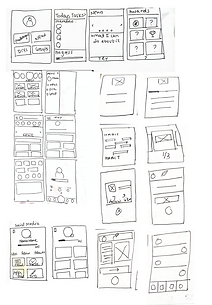
EcoSurge
UX | UI | App Design
Eco Surge was an innovative app concept designed to inspire eco-friendly habits, created as part of the Blue Spaceshipproject. Guided by Susmita Mohanty, a renowned spaceship designer and climate ambassador, and Mahesh Bhat, a celebrated photographer and environmental activist, the project combined creativity and sustainability to drive meaningful change.

The climate crisis demands action, yet many are unsure how to turn awareness into impactful change.
T H E C H A L L E N G E
We are in the midst of a climate crisis—undeniable, alarming, and deeply real. Wildfires, torrential rains, rising seas, melting glaciers, and the relentless march of global warming are no longer distant warnings but lived realities, disrupting lives and ecosystems alike. The facts are clear, and the urgency is palpable. But what comes next? The path forward is anything but simple. There’s no checklist, no one-size-fits-all solution to make these challenges vanish. It’s overwhelming to know where to begin or how to act meaningfully in the face of such vast and complex issues.
R E S E A R C H
The research involved engaging with individuals from diverse backgrounds to explore their perspectives on climate change.
Research Approach
I employed a structured methodology of interviewing, analyzing insights, observing behaviors, and conducting further analysis to gain a comprehensive understanding.
Research Goals
-
Understand how users learn about climate change.
-
Explore their overall feelings and attitudes toward climate change.
-
Observe if and how they take measures to combat climate change in their daily lives.
Masterclasses with environmental experts and immersive research tours were pivotal to my primary research. These experiences, including visits to Hessarghatta, Mangalore, and Coorg, offered firsthand exposure to the natural world and deepened my understanding of climate challenges. Witnessing nature up close was an eye-opening journey that enriched my insights.
EXPLORING DIFFERENT FORMS OF NATURE AND LANDSCAPES


Secondary Research
-
The aim of my secondary research was to explore:
-
Climate anxiety and procrastination.
-
Human behavior in terms of habits and rewards.
-
The role of games and gamification in motivating change.
-
A deeper understanding of climate change and its impacts.
G A M E D E S I G N


As part of my research into game design, I identified two critical frameworks that inform engaging and meaningful player experiences. The first framework highlights the feedback loop in game design, where players devise actions based on their mental models. These actions interact with the game’s rules to produce outcomes or feedback, which in turn influence and refine the player’s understanding of the game. This iterative process ensures a dynamic relationship between players and the system. The second framework focuses on the principles behind designing fun, emphasizing core elements such as attention, care, respect, and commitment. It underscores that creating fun involves embracing complexity, fostering a sense of playfulness, and treating the design process with intentionality and respect for the medium. These findings provide a foundation for crafting immersive and satisfying game experiences while balancing challenge, engagement, and creativity.

U N D E R S T A N D I N G
C L I M A T E
C H A N G E
A N A L Y S I S O F R E S E A R C H
I conducted an in-depth analysis of user behavior to identify key stages in their daily interactions with information and opportunities for system design. Here's what I discovered:
-
Daily Action: This represents users' comfort zone—the activities they perform habitually throughout the day. It is essential to design systems that seamlessly integrate into these routines to maximize usability and adoption.
-
Discovery: This is where users encounter new information, typically through news, social media, or word of mouth. Understanding these touchpoints allows us to identify where and how to introduce meaningful interventions.
-
Research: Once exposed to new information, users often seek to learn more. I focused on analyzing how users consume, verify, and process this information to identify gaps and pain points.
-
New Behavior: At this stage, users evaluate actions they could take, whether to address a situation or contribute positively. Designing systems to support decision-making and actionable insights is critical here.
-
Loss of Motivation: Over time, users may lose momentum, either because they feel powerless to make a difference or become fatigued from repeated efforts. Mitigating this challenge involves designing for sustained engagement and reducing friction in the process.

From these insights, I mapped out opportunities for intervention and ideated three potential solutions:
-
Credible and comprehensible information (Fact Checker): A tool to help users verify information easily and confidently.
-
Awareness of Vicinity: A system providing hyperlocal insights to users, empowering them to act on issues or opportunities around them.
-
Awareness of Vicinity and Habits: A deeper integration of localized awareness with habit-tracking to encourage meaningful, consistent actions.
Using a SWOT analysis, I evaluated these ideas and selected the most viable option. This decision was followed by a comprehensive study of existing apps, focusing on their flow and interaction design to ensure an intuitive and effective user experience.
This iterative process not only helped me align the solution with user behavior but also ensured the system's relevance and potential for sustained impact.
R O U G H W I R E F R A M E S






T A S K F L O W

A P P L I C A T I O N O V E R V I E W


